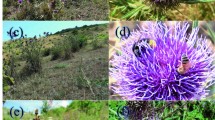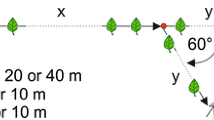Summary
Crab spiders Misumena calycina (L.) in pasture rose Rosa carolina flowers regularly attacked bumble bees, smaller bees, and syrphid flies that visited these flowers. Attacks reached a maximum rate of over 20/h during mid morning, but only 1.6% of the most important prey item, bumble bees, were captured. The next most important food source, the most frequently taken item, syrphid flies Toxomerus marginatus (Say), were captured in 39% of the attempts. Since these flies have a biomass only 1/60th that of bumble bees, they comprised a much less important food source than did bumble bees. Spiders would obtain over 7% more food by specializing on bumble bees than by attacking all insect visitors, and as much as 20% more food at certain times of the day. However, they did not show a tendency to specialize at any time.
Similar content being viewed by others
References
Charnov, E.L.: Optimal foraging; attack strategy of a mantid. Am. Nat. 110, 141–151 (1976)
Covich, A.: Analyzing shapes of foraging areas: some ecological and economic theories. Annu. Rev. Ecol. Syst. 7, 235–258 (1976)
Davies, N.B.: Prey selection and the search strategy of the spotted flycatcher (Muscicapa striata): a field study of optimal foraging. Anim. Behav. 25, 1016–1033 (1977)
Gertsch, W.J.: A revision of the typical crab-spiders (Misumeninae) of America north of Mexico. Bull. Amer. Mus. Nat. Hist. 76, 277–442 (1939)
Gill, F.B., Wolf, L.L.: Foraging strategies and energetics of East African sunbirds at mistletoe flowers. Am. Nat. 109, 491–510 (1975)
Goss-Custard, J.D.: Optimal foraging and the size selection of worms by the redshank, Tringa totanus, in the field. Anim. Behav. 25, 10–29 (1977a)
Goss-Custard, J.D.: The energetics of prey selection by redshank, Tringa totanus (L) in relation to prey density. J. Anim. Ecol. 46, 1–19 (1977b)
Krebs, J.R., Erichsen, J.T., Webber, M.I., Charnov, E.L.: Optimal prey selection in the great tit (Parus major). Anim. Behav. 25, 30–38 (1977)
Lovell, J.H.: Insects captured by the Thomisidae. Can. Entomol. 47, 115–116 (1915)
MacArthur, R.H.: Geographical ecology. New York: Harper and Row (1972).
MacArthur, R.H., Pianka, E.R.: On optimal use of a patchy environment. Am. Nat. 100, 603–609 (1966)
Pulliam, H.R.: Diet optimization with nutrient constraints. Am. Nat. 109, 765–768 (1975)
Pyke, G.H., Pulliam, H.R., Charnov, E.L.: Optimal foraging: a selective review of the theory and tests. Quart. Rev. Biol. 52, 137–154 (1977)
Schoener, T.W.: Models of optimal size for a solitary predator. Am. Nat. 103, 277–313 (1969)
Smith, J.N.M., Dawkins, R.: The hunting behaviour of individual great tits in relation to spatial variations in their food density. Anim. Behav. 19, 695–706 (1971)
Smith, J.N.M., Sweatman, H.P.A.: Food-searching behavior of titmice in patchy environments. Ecology 55, 1216–1232 (1974)
Stein, R.A., Magnuson, J.J.: Behavioral response of crayfish to a fish predator. Ecology 57, 751–761 (1976)
Tinbergen, L.: The natural control of insects in pinewoods. I. Factors influencing the intensity of predation by song birds. Arch. Néerl. Zool. 13, 265–343 (1960)
Werner, E.E., Hall, D.J.: Optimal foraging and size selection of prey by the bluegill sunfish (Lepomis macrochirus). Ecology 55, 1042–1052 (1974)
Wilson, D.S.: The adequacy of body size as a niche difference. Am. Nat. 109, 769–784 (1975)
Author information
Authors and Affiliations
Rights and permissions
About this article
Cite this article
Morse, D.H. Prey capture by the crab spider Misumena calycina (Araneae: Thomisidae). Oecologia 39, 309–319 (1979). https://doi.org/10.1007/BF00345442
Received:
Issue Date:
DOI: https://doi.org/10.1007/BF00345442




